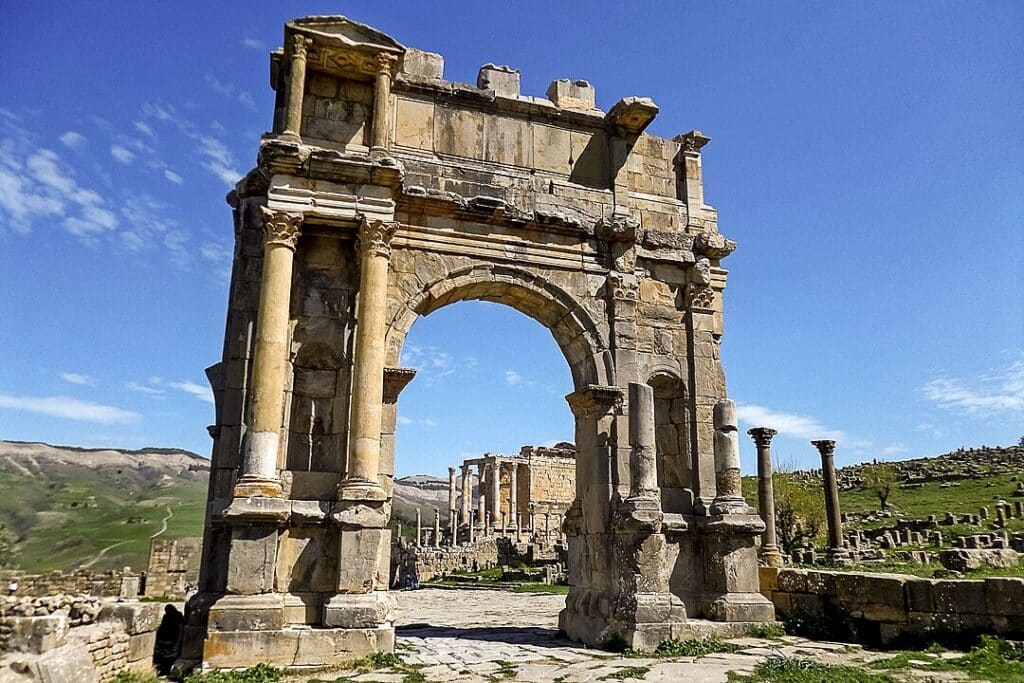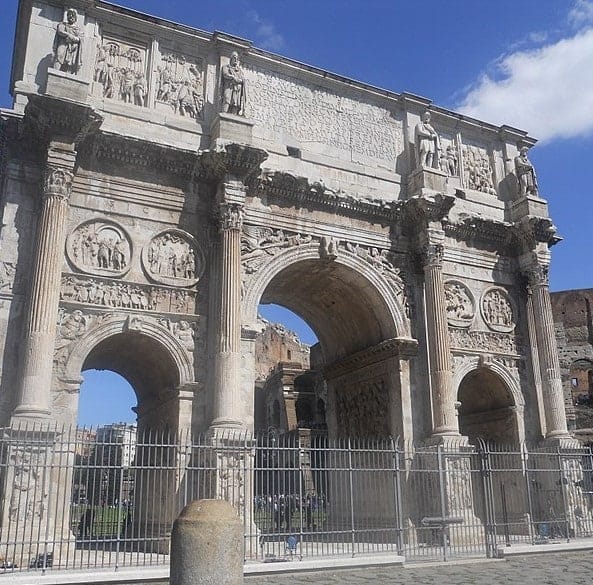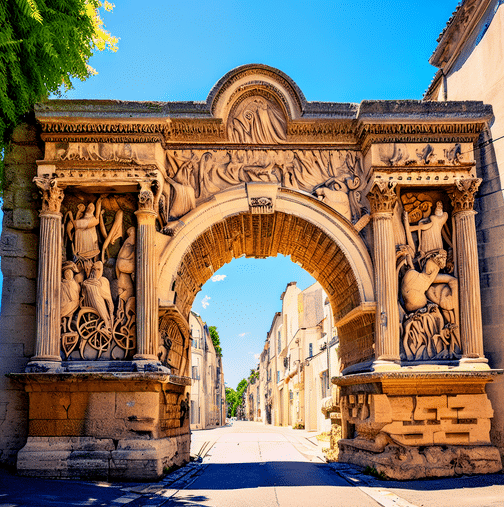
Roman arches stand as timeless testaments to the architectural genius of the ancient Roman civilization. These impressive structures have withstood the test of time, captivating visitors with their grandeur and precision engineering. In this article, we will embark on a journey through history, exploring the top 10 Roman arches that continue to inspire awe and admiration. From iconic triumphal arches to majestic aqueducts, join us as we unravel the splendor of these architectural marvels.
- The Colosseum, Rome, Italy

At the heart of Rome stands the legendary Colosseum, a symbol of Roman innovation. This monumental amphitheater features a series of arches that not only lend strength to the structure but also create an awe-inspiring visual spectacle. The Colosseum’s grandeur has made it one of the most iconic symbols of ancient Rome.
- Arch of Constantine, Rome, Italy

Dedicated to Emperor Constantine, the Arch of Constantine is a triumphal arch that commemorates his victory. This majestic structure showcases intricate reliefs and sculptures, depicting scenes from Roman history. Its massive arches are a testament to the architectural prowess of the Romans.
- Pont du Gard, Nîmes, France
The Pont du Gard is a remarkable aqueduct bridge that spans the Gardon River. This Roman engineering marvel features three tiers of arches, showcasing the precision and durability of Roman construction techniques. Its timeless beauty and functional design have earned it a UNESCO World Heritage status.
- Arch of Septimius Severus, Rome, Italy
Located in the Roman Forum, the Arch of Septimius Severus celebrates the military victories of Emperor Septimius Severus. This triumphal arch, adorned with intricate carvings and reliefs, serves as a testament to the might of the Roman Empire.
- Arch of Titus, Rome, Italy
The Arch of Titus, situated in the heart of Rome, commemorates Emperor Titus’s conquest of Jerusalem. Its elegant design and detailed reliefs offer a glimpse into the rich history of the Roman Empire. The arch’s remarkable preservation makes it a must-visit for history enthusiasts.
- Arco di Augusto, Rimini, Italy
The Arco di Augusto in Rimini is one of the oldest Roman arches in existence. Built to honor Emperor Augustus, this arch showcases the classic Roman architectural style and stands as a symbol of the city’s rich history.
- Arch of Hadrian, Athens, Greece
As a gateway between the old and new parts of Athens, the Arch of Hadrian carries a unique historical significance. Constructed in honor of Emperor Hadrian, this triumphal arch serves as a reminder of the deep connections between Rome and Greece.
- Arch of Galerius, Thessaloniki, Greece
The Arch of Galerius, also known as the Kamara, is a testament to the influence of Roman architecture beyond the borders of Italy. This ornate triumphal arch in Thessaloniki features intricate carvings that depict scenes from Galerius’s military campaigns.
- Arch of Trajan, Ancona, Italy
Located in the port city of Ancona, the Arch of Trajan commemorates the Roman Emperor Trajan’s construction of the harbor. This triumphal arch is adorned with exquisite carvings and is a prime example of the Roman architectural style.
- Arch of Marcus Aurelius, Rome, Italy
The Arch of Marcus Aurelius, situated in the historic center of Rome, honors the Emperor Marcus Aurelius and his military victories. This beautifully preserved triumphal arch provides a glimpse into the grand
Roman arches are architectural structures that were a defining feature of ancient Roman architecture. They are semicircular or rounded arches that were used extensively in Roman construction, both for practical and aesthetic purposes. Roman arches were constructed by arranging wedge-shaped stones called voussoirs in a curving formation, with the central keystone at the top locking the arch in place.
The Romans employed arches in various types of structures, including bridges, aqueducts, gateways, and triumphal arches. The arches provided exceptional strength and stability, allowing for the construction of large and durable structures. The use of arches enabled the Romans to span wider distances and create spacious interiors without the need for massive supporting walls.
The design and engineering principles behind Roman arches were groundbreaking during their time. By distributing the weight of the structure evenly along the curve of the arch, they could support heavy loads and withstand the forces of gravity. This architectural innovation allowed the Romans to create expansive public buildings, grandiose monuments, and efficient infrastructure.
What are the Roman arches?
Roman arches became an iconic symbol of Roman civilization and their advanced engineering skills. They continue to inspire awe and admiration, standing as enduring testaments to the ingenuity and craftsmanship of the ancient Romans. Today, the remains of Roman arches can still be found in various parts of the world, serving as a reminder of the lasting legacy of Roman architecture.
What were Roman arches famous for?

Roman arches were famous for several reasons, as they played a significant role in shaping ancient Roman architecture and engineering. Here are some of the notable characteristics and achievements associated with Roman arches:
- Structural Innovation: Roman arches were renowned for their structural stability and strength. By distributing the weight of the structure along the curve of the arch, they could support heavy loads and span wider distances without the need for massive supporting walls. This innovation allowed for the construction of large and durable structures, including bridges, aqueducts, and monumental buildings.
- Architectural Versatility: Roman arches were used in a wide range of architectural structures, showcasing their versatility. They were integral components in the construction of aqueducts, carrying water across vast distances, ensuring a reliable water supply to cities. Arches were also employed in the creation of monumental structures such as triumphal arches and gateways, providing a lasting impression and symbolizing Roman power and glory.
- Aesthetic Appeal: Roman arches were not only functional but also aesthetically pleasing. Their graceful curves and proportions added a sense of grandeur and elegance to architectural designs. The meticulous craftsmanship and intricate detailing of the arches, including decorative carvings and reliefs, exemplified the Romans’ commitment to architectural beauty.
- Engineering Mastery: The Romans demonstrated remarkable engineering skills in the construction of arches. They developed techniques for precisely cutting and fitting the wedge-shaped stones, known as voussoirs, to form the arch. The use of a central keystone to lock the arch in place ensured its stability and integrity. These engineering achievements revolutionized the construction industry of the time and set the foundation for future architectural advancements.
- Enduring Legacy: The legacy of Roman arches can be witnessed in the lasting impact they have had on architectural styles and techniques. The principles and designs of Roman arches influenced subsequent civilizations and architectural movements, leaving an indelible mark on architectural history. Even today, remnants of Roman arches stand as iconic symbols of ancient Roman civilization and continue to inspire awe and admiration.
In summary, Roman arches were famous for their structural innovation, architectural versatility, aesthetic appeal, engineering mastery, and lasting legacy. They represented the ingenuity and advanced engineering skills of the ancient Romans, leaving an enduring impact on the field of architecture.
Why are Roman arches so strong?
Roman arches are renowned for their strength due to several factors that contribute to their structural integrity. Here are the key reasons why Roman arches are exceptionally strong:
- Weight Distribution: Roman arches are designed to distribute the weight of the structure evenly along the curve of the arch. This characteristic allows the arch to efficiently transfer the load downwards and outwards to the supporting columns or piers. By spreading the weight over a larger area, the arch can withstand heavy loads and prevent concentrated stress points.
- Key Keystone: The keystone is the central stone at the top of the arch, which plays a crucial role in the arch’s stability. It is specifically shaped to lock the other stones, known as voussoirs, into place. The keystone is responsible for distributing the load to the adjoining voussoirs and ensuring that each stone supports the others. The compression forces created by the keystone and the voussoirs work together to hold the arch in place.
- Wedge Shape: Each voussoir in a Roman arch is cut into a wedge shape, wider at the bottom and tapering towards the top. This design creates a natural inclination for the stones to push against each other, resulting in compressive forces that strengthen the arch. The inclined sides of the voussoirs help to distribute the load evenly and prevent the stones from slipping outwards.
- Strategic Materials: The Romans used durable and strong materials for their arches, such as stone, concrete, and brick. These materials were carefully selected for their ability to withstand compressive forces and resist deterioration over time. The precise cutting and fitting of the stones ensured a tight and secure bond between the voussoirs, enhancing the overall strength of the arch.
- Structural Redundancy: Roman arches often incorporated multiple arches or arcades in a row, creating a series of arches supported by columns or piers. This arrangement increased the redundancy and stability of the structure, as the load was distributed across multiple arches and support points. The redundancy minimized the risk of failure and provided additional strength to the overall architectural composition.
Through a combination of weight distribution, the use of a key keystone, the wedge shape of the voussoirs, the choice of robust materials, and the incorporation of structural redundancy, Roman arches achieved exceptional strength and durability. These design principles and engineering techniques have been widely studied and applied in architecture throughout history, further demonstrating the enduring strength and significance of Roman arches.
What is the origin of the Roman arches?
The origin of Roman arches can be traced back to ancient Mesopotamia and Egypt, where early arch-like structures were used in construction. However, it was the ancient Romans who perfected the design and widespread implementation of the arch in their architectural projects.
The Romans adopted and refined the arch from their predecessors, incorporating it into their construction techniques and architectural vocabulary. They expanded upon the earlier methods and developed innovative approaches to create arches that were structurally robust and aesthetically pleasing.
One of the significant advancements credited to the Romans was the use of the keystone, a central stone that locks the arch in place. This key element in arch construction helped distribute the weight and forces evenly, ensuring stability and strength.
The Romans also introduced new materials and building techniques to enhance the arch’s capabilities. They employed durable materials such as stone, concrete, and brick, allowing for larger and more ambitious architectural projects. Their expertise in stone cutting and fitting allowed for precise construction and secure interlocking of the voussoirs, reinforcing the arch’s structural integrity.
As the Roman Empire expanded, so did the influence of their architectural style. Roman arches became ubiquitous throughout the empire, utilized in various structures such as bridges, aqueducts, triumphal arches, and public buildings. Their extensive use demonstrated the Romans’ mastery of arch construction and their ability to create enduring structures.
The Roman arches left a lasting impact on architectural history and served as a foundation for subsequent architectural styles. The principles and techniques developed by the Romans were disseminated across Europe, influencing the architecture of subsequent civilizations, including Byzantine, Gothic, and Renaissance periods.
In summary, while the concept of arches predates the Romans, it was the ancient Romans who refined and popularized their use in construction. Through their engineering innovations and architectural achievements, the Romans perfected the design, construction techniques, and widespread implementation of arches, leaving an enduring legacy in the field of architecture.
